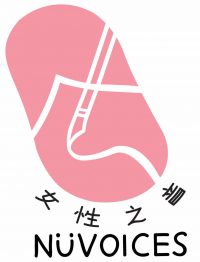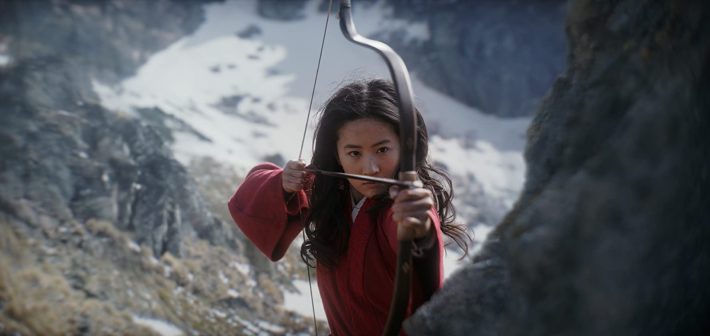BY EMILY MATSON
In the opening scene of “Mulan,” the camera pans out to a desert situated in what is referred to as “the Silk Road, Northwest China.” After a man leading a small caravan of camels across the sand dunes is possessed by a female witch, he enters the marketplace of a small garrison guarded by Chinese soldiers. Suddenly, a band of fearsome black-clad Rourans, the antagonists of the film, are spotted galloping swiftly towards the fortress on sable horses. Although the gates are quickly closed, the heroic guardsmen are no match for their ruthless enemy. Shown as possessing considerable martial prowess, the Rourans are somehow able to run up walls, and under the leadership of the cruel Bori Khan, massacre the garrison’s inhabitants.
This scene and others throughout the film contain problematic tropes, historical and cultural inaccuracies, and questionable assumptions about “China” that seem to cater to the Chinese Communist Party (CCP)’s preferred image of the country.
In Chinese, the northwestern region of Xinjiang literally translates to “new territories” precisely because it was not brought under the control of any Chinese dynasty until the Qing Dynasty. During the time of the Northern Wei Dynasty (386-581 AD), from when the ballad of Mulan originated, the rival southern Qi and Liang Dynasties reigned to the south, the Rouran and Khitans to the north, and the Tuyuhun and other tribes to the west. As historian Kelly Hammond explains in a CNN report: “in the original ballad, Mulan is loyal to her Khan, not a Chinese emperor…This indicates that Mulan was a member of the Touba clan…rather than a Han Chinese.”
Han ethnonationalism that is “akin to white-washing”
The fact that the term “Northwest China” is utilized in the historical setting of Hua Mulan’s legend is troubling, to say the least. By portraying Xinjiang as part of “China” from time immemorial, this Han-icizes Uighur history, erasing its unique culture from the historical narrative and contributing to the current authoritarian regime’s efforts to claim the region, along with other peripheral regions such as Inner Mongolia and Tibet, as its own. Hammond, assistant professor of East Asian history at the University of Arkansas, notes that appropriating non-Han history for the purpose of Han ethnonationalism is akin to “white-washing” in American history.
Another obvious nod to Han superiority in the film is through the ethnic othering of the Rourans. Mulan, her family, and her army companions all have pale complexions and hairless skin. In stark contrast, the Rourans, of proto-Mongolic origin, are hairy and dark-skinned. This is similar to the 1998 Disney animation portrayal of the Huns as sallow-skinned, wild-eyed barbarians – a caricature of Inner Asian step peoples that, according to James Millward, professor of Inter-societal History at Georgetown University, “is as racist as Aunt Jemima or Uncle Ben (in US popular culture).”
In other words, the enemies of “China” are cast as uncivilized ethnic outsiders to be subdued by the Han. By not questioning Han superiority, “Mulan” ends up reinforcing it. This is highly problematic, particularly in the context of the ongoing crackdown on Uyghur Muslims in China and unprecedented protests in Inner Mongolia over the CCP’s attempts to limit the teaching of the Mongolian language in schools.
The myth of a timeless, generic “China”
Cultural inaccuracies in the film also attest to the filmmakers’ attempts to make “Mulan” as generically “Chinese” as possible. Mulan and her family live in a circular, communal living space common to the Hakka group known as a tulou house in today’s Fujian province. However, historically these houses were not used until about a thousand years after the “Ballad of Mulan.” Moreover, Mulan herself would have been a heroine from Northern China. The bright, elaborate costumes worn by Mulan at her initiation ceremony and by the other women belong more in the Tang Dynasty than in the Northern Dynasties, and the accompanying make-up is gaudy and overdone at best.
This view of a generic “China” imparts a certain timelessness to the Communist Party that seamlessly unites it with the dynastic era. This, and the positioning of the center of Chinese power at the generic “Imperial Court, Central China,” lends credibility to the catch-all “Chinese dream” and nationalistic vision of China that the party, and Chinese President Xi Jinping, promotes.
“Feminism” that fails to challenge the patriarchy
Lastly, while “Mulan” is supposed to be a feminist film, there are multiple ways in which patriarchal assumptions still dominate the plot. Firstly, the entire film is narrated not by Mulan, but by her father – in the end, it is still a man that is controlling the narrative. Secondly, Mulan only gains the respect of her male companions in the army by brandishing her “masculine” traits of courage, strength, and wit. The movie does, in effect, “make a man out of (her).”
The fact that having a strong qi is portrayed as masculine makes Mulan an exception to the female ideal, not an example to be embodied by other women. This, too, in a way buys into CCP norms regarding gender equality, which “equalizes” women and men without challenging patriarchal structures. Today, the party still parrots rhetoric about gender equality while providing few opportunities for women in spheres of power.
In this remake, Disney is not only shamelessly kowtowing to the CCP’s political agenda, but also promoting historico-cultural inaccuracies and a watered-down version of feminism that serves no one.
PODCAST: “What’s next for Hollywood and China after ‘Mulan’ flop?”
About the author

Emily Matson is a PhD candidate at the University of Virginia, studying modern Chinese history. Matson’s dissertation is on museums in Northeastern China that commemorate the Manchukuo era and how this regional narrative has interacted with the national narrative from Beijing over time. In addition to modern Chinese history, she also has expertise in modern Japanese history and the interdisciplinary field of historical memory.

